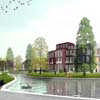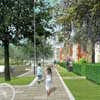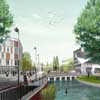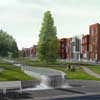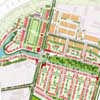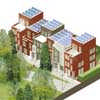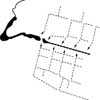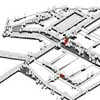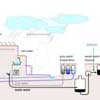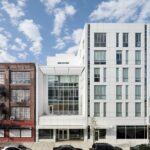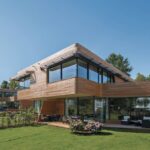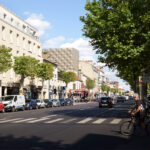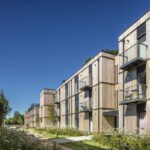Neues Wohnen Hamburg-Jenfeld, Building, Project, Photo, News, Design, Property, Image
Ecological Development in Hamburg, Germany
Hamburg Housing by West 8: German Residential Property Design, Europe
28 Jan 2010
Neues Wohnen Hamburg-Jenfeld
West 8 wins International Urban Landscape Gold Award
Rotterdam, 28 January 2010 – West 8’s project “Neues Wohnen in Hamburg-Jenfeld”, designed for the City of Hamburg Bezirk Wandsbek, Bundesanstalt für Immobilienaufgaben and BSU, has been awarded the Gold Award in this year’s International Urban Landscape Award (IULA). The ecological neighbourhood project is the winner of the €25,000 prize.
“Neues Wohnen in Hamburg-Jenfeld” is a new ecological development neighbourhood in Hamburg-Germany, for living and working, which combines low carbon housing and renewable energy. Based on the winning competition entry, West 8 designed the masterplan for the urban development, the landscape strategy and the architectural guidelines for the sustainable realization of the new area. Three design principles play a prominent role: partial collectivity and clear individuality, coupled with social and ecological sustainability.
Eurohypo AG, one of the leading international specialist banks for real estate and public finance sponsored the award to find the UK’s and Germany’s most ground breaking urban architecture concept and project. IULA aimed to find urban design solutions for the challenges of dynamic population changes and shifting economies, as well as creative concepts for social and economic integration within the city and its districts, placing emphasis on energy-efficient and resource optimised construction.
Dr. Frank Poerschke, Chairman of Eurohypo AG said:
“Eurohypo was delighted by the responses we have received for IULA and are pleased to present the awards to “Neues Wohnen in Hamburg-Jenfeld” as well as the Lea River and LifE Project. All three award winners demonstrated the attributes that the jury was looking for in terms of identifying creative low carbon concepts for social and economic integration within the city and its districts. In total, the quality of all 43 projects submitted was extremely high and the expert jury had to make tough decisions.”
Hamburg-Jenfeld images © West 8 urban design & landscape architecture
Project Description
Living in New Jenfeld
An ecological neighbourhood
Revitalization of Lettow-Vorbeck-barracks Hamburg-Jenfeld
The future theme “Growing City” was the starting point of the task for the district Jenfeld to create a distinctive range of diverse building types and a variety of public spaces. Jenfeld is known as a characterless neighbourhood in the east of Hamburg with a high proportion of social housing and an anonymous uniform appearance. The district Wandsbek has made it a priority to improve the image of Jenfeld by redeveloping and revaluating the built environment. The conversion of the former barracks area will support this change of image.
Social sustainability
For Jenfeld three design principles play a prominent role. Partial collectivity and clear individuality, coupled with sustainability. One of the main goals for the urban design is to achieve a wide variety of different residents, an urban mix of younger and older people, from lower to upper middle class.
This mix should be achieved by offering a wide variety of housing types with individual charisma. The compact size of the plots makes the individual plots attractive: an affordable townhouse with a garden, located within the city limits of Hamburg in a vivid, high-quality environment and part of a network of urban and social organizations.
The addition of various functions such as small businesses, services, municipal facilities, gastronomy, retail and day care turns Jenfeld into a “city of social sustainability”. This will be reinforced by clear public space elements such as the Cascade Park, Kühnbachteich, a central avenue for Kellogstraße-Wilsonstraße and gardens to rent at the Kasernenhof; it all forms a well-defined network.
Highlight in the network of open spaces is the main square. The clearly defined space at the junction of the central avenue and the Kaskadenpark is provided with a mix of cultural, social and public functions and reflects the warmth, the sociability of the neighborhood and the social control.
Sustainability also means the creation of long-term usable structures. The urban and compact block structure and clear public and private areas with high residential quality, the integration and combination of different building types as well as the orientation on special design principles form the design requirements for a long-term attractive, robust and flexible part of the city. The new housing in Jenfeld will set a new standard.
The main task of the urban design plan is the development of the townhouses, a combination of a row house and a freestanding family home, which offer the possibility to live in an urban atmosphere without losing the possibility of having your own garden. This typology offers an attractive alternative for living in the often monotonous suburban developments. It is an expression of personal lifestyle of the individual resident or family. Within the townhouse type a variety of housing types can be found. The type is not fixed upon a specific age group or target group; it will attract a colorful mix of different generations and cultures.
One of the most important aspects of the design is the individual unity of each building. This means that the buildings can stand alone, but also can be attached to each other, which will intensify the lively urban atmosphere of the neighborhood. The buildings are close together, their proportions are relatively narrow and high, and the corresponding plots are very compact. The combination of these characteristics enables the realization of affordable housing units with a strong expression. Due to the relatively high density, a quarter of small-scale, yet urbanized, can arise.
Although each building will have its individual character, it is possible to develop a large number of houses at once: the developer offers potential buyers an architectural variety of housing types, and each individual house can then have its own façade design. This makes a natural architectural mix possible.
At the same time it is also important to create a harmonious and coherent neighbourhood, despite the individuality. Therefore a common canon of design is crucial. It will establish identity and security. The design of the quarter aims for “unity in diversity”. The diversity of new housing in Jenfeld depends to a large extent on the color of every building.
Despite the strongly desired richness of color a least common denominator should be followed to prevent a creative cacophony.
The colors are natural shades of burnt clinker, a warm, earthy material. Colors range from broken white through a discreet red, modest and subdued orange-brown to dark gray. All colors have a conservative tone. The warm red-orange-brown color is the most occurring color stimulus.
Ecological sustainability
The idea of sustainability also means that construction and use of the buildings are ecologically sound and follow a responsible use of natural resources. The compact design of the new quarter spares the surrounding landscape and leaves enough room for green spaces.
The buildings are equipped with modern technology to save energy, water and other resources. A future-oriented neighborhood will be built, that is self sufficient in terms of energy use and that can survive without the conventionally produced net- and heat energy. This corresponds to the climate-protection concept of the Freien & Hansestadt Hamburg.
To this end, Hamburg Wasser, by order of the district of Wandsbek, has developed HAMBURG WATER Cycle ® (HWC), an innovative scheme based on the functional plan of Jenfeld. The system provides sanitation, power generation and delivers energy directly into the neighbourhood.
The components of the HWC consist of a balanced combination of solar heat, geothermal energy and energy that is generated by heat pumps, boilers and peak power cogeneration.
Rainwater, waste water and grey water have different tasks in HAMBURG WATER Cycle ®. All rainwater will be collected in small trenches along the streets to feed the water cascade and then flow into the central pond, which will act as a water retention basin. The waste water from toilets is used for energy production (biomass). The incidental grey water (from showers and washing machines etc.) is filtered and also flows into the central pond.
The roofs of the residential buildings will be equipped with a maximum of photovoltaic and solar thermal systems. The use of the roofs and the design of the townhouses should not adversely affect each other. The technical installations should be understood as a conscious design element and not to be placed randomly.
Solar systems require a specific slope of the roof facing south. Depending on the orientation of each building the slope has different consequences on the interplay of the roof surfaces of a city block. Hereby, roof surfaces must either be inclined as a whole (pent roofs and symmetrical pitched roofs) or so that the solar panels are largely hidden by a roadside attica (flat roofs).
Together with the biogas plant in the cogeneration system, 50% of the required electricity is to be produced locally. The heating demand is covered to 100% in the quarter itself. The system also provides an economically interesting alternative to conventional power, polluting the environment.
Hamburg-Jenfeld Neighbourhood – Development Information
Location: Hamburg, Germany
Competition: Kooperatives Gutachterverfahren, First Prize, 2005
Start realisation: 2010
Size: 29 ha.
Client: Bundesanstalt für Immobilienaufgaben/ BSU/ Bezirk Wandsbek
Hamburg-Jenfeld images / information from West 8 urban design & landscape architecture
Location: Hamburg, Germany
New Architecture in Hamburg
Contemporary Hamburg Architecture
Hamburg Architecture Designs – chronological list
Hamburg Architecture Walking Tours by e-architect
Hamburg Architecture – Selection
Elbphilharmonie
Herzog and de Meuron
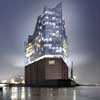
image © Herzog & de Meuron
Hamburg Science Centre
OMA
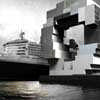
image from architect
Kaufhauskanal housing
BIG Architects

image from architect
Comments / photos for the Neues Wohnen in Hamburg-Jenfeld Hamburg Architecture page welcome


